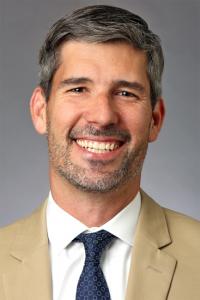Spotlight on Benjamin D. Roye, MD
Weinberg Family Cerebral Palsy Center Provider Spotlight
Benjamin D. Roye, MD, is a pediatric orthopedic surgeon specializing in scoliois and other complex pediatric spinal disorders. Dr. Roye has been part of the WFCPC's team treating children with cerebral palsy since the center was founded. In addition to his clinical work, he is an active member of the Pediatric Spine Study Group, one of the most important spinal deformity study groups in the world. We spoke to Dr. Roye about spine awareness and his work with children with cerebral palsy.
1. Dr. Roye, what is it that makes you so passionate about spine deformity surgery?
Spinal deformities can be incredibly debilitating to patients, leading to pain, misshapen bodies, and difficulties with breathing, digestion and even heart function in severe cases. There is something very satisfying about realigning a spine that is deformed, and the knowledge that we are at a minimum preventing significant problems in the future, and in many cases improving quality of life immediately, is tremendously rewarding.
2. How is caring for a cerebral palsy patient with progressive scoliosis different from dealing with a typically developed child with a spine deformity?
Children with CP usually have different goals than typically developed children. Most of the children with CP and severe scoliosis do not walk independently, and typically spend their day in a chair - so sitting balance is critical, and often quite difficult with scoliosis. The curved spines can lead to pressure sores, pain, increased abdominal pressure leading to worsening gastric reflux, and even breathing difficulties. These types of problems are rarely present in the typically developed child.
3. What measures can parents take to slow the progression of neuromuscular scoliosis for child with CP?
There are few studies showing any definitive way to slow progression of scoliosis in children with CP, but we will often use spine braces, especially in younger children, to try to slow down progression. Soft body jackets are also used at times, but more to facilitate better sitting posture, and not so much to slow progression.
4. The clinical research in your division reports an easing on the burden of care for caregivers after scoliosis surgery in CP. Can you share what is it about your surgery that makes care of these involved children easier?
After surgery, these children sit beautifully, so getting them stable and comfortable in their chairs is much easier after surgery. Additionally, for some patients, especially those with more severe deformity, after surgery they may require less help with their breathing, fewer pneumonias and less pain.
5. You are very involved with the Pediatric Spine Study Group at the Pediatric Spine Foundation PSSG. Can you share some of the latest (or prominent) projects related to CP?
Many of our projects include children with a variety of conditions, including CP. Right now I am looking at factors associated with hardware failure (broken rods) that includes those with CP. Additionally, we are looking at the impact of complications on quality of life, and factors that can help us decide if a growing rod is necessary in younger children, as opposed to a more standard spinal fusion.
6. What do you do when you’re not being an orthopedic surgeon?
Sleeping! No, just kidding, I enjoy skiing with my family in the winters, swimming in the summers, walking our two golden retrievers, and cooking, especially grilling and smoking on one of my grills.
Learn more about Dr. Roye here.

